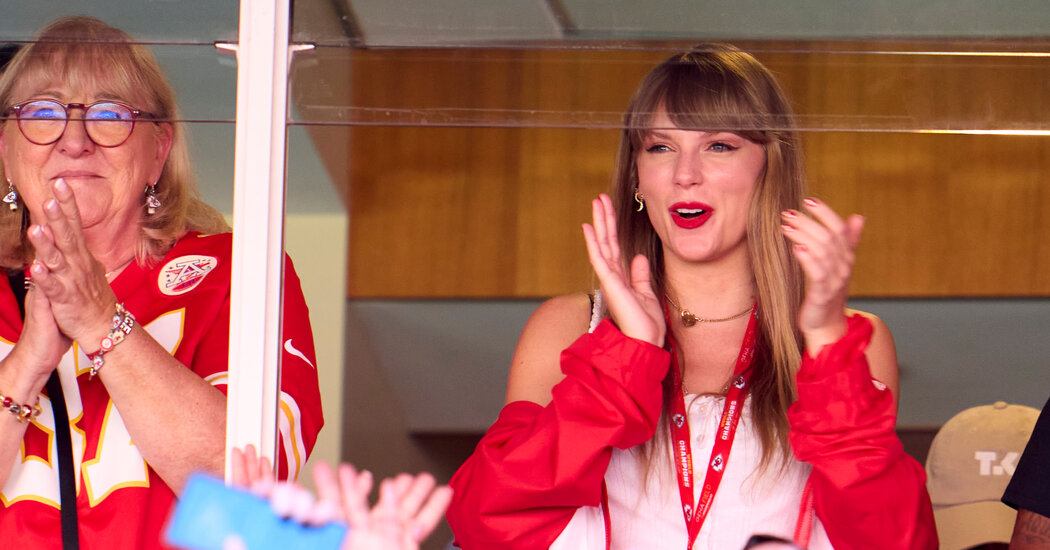The Buffet Is Back in the U.S., From Las Vegas to Small Southern Towns
The buffet got creamed during the pandemic. Even when diners crept back into restaurants covered in hand sanitizer, a model of eating based on shared serving spoons and food seasoned with the breath of strangers seemed like a goner.
But the all-you-can-eat buffet, that symbol of America’s love of choice and penchant for excess, will not be denied. From piles of crab legs at swank Las Vegas casinos to pans of fried chicken in small-town Southern restaurants, the buffet is back, baby.
“The media called buffets zombie companies — we didn’t know we were dead,” said Lance Trenary, the chief executive of Golden Corral, whose 360 restaurants offer unlimited helpings of 150 different items for less than $20. “But we’re the comeback kids. Year to date, we’re running about 20 percent up.”
At a time when inflation has driven up the cost of both groceries and restaurant meals, the renewed popularity of an inexpensive chain-restaurant buffet could be explained as a value proposition. But at the most lavish spreads in Las Vegas, where dinner can cost $79.99 before cocktails and tax, reservations remain hard to come by and waits can stretch to more than two hours.
Demand is so strong that Bellagio last month reopened its signature buffet for dinner, with 120 choices. The Bacchanal buffet at Caesars Palace, the largest in Las Vegas, recently got a nearly $10 million face-lift and added two extra days to its brunch schedule.
“Americans love big things. That’s it,” said Allison Corona, a data analyst from Pittsburgh whose recent five-day trip to Las Vegas with her husband and friends included four buffets. “We just love more. I’m not saying that’s good. I’m just saying it’s who we are.”
Buffets speak to an American dining culture that prizes consistency, value and choice. They can make people of modest means feel rich, if just for an hour or two. They provide culinary road maps for recent immigrants and culinary tourism for those who haven’t traveled much. A buffet can be as communal as a church picnic.
Buffets also cater to that secret place within the American diner that just wants to pile it on — despite attempts to rebrand “all you can eat” as the more genteel “all you care to eat.”
Lilly Jan, a food and beverage management lecturer at Cornell University’s school of hotel administration, calls it the Cheesecake Factory effect.
“Americans want the consistency because they are afraid to take risks with their dollars as relates to food,” she said. “They want to go somewhere with the kids where everyone can have what they want and it doesn’t break the bank, but they want to make it an experience.”
Still, the buffet landscape has been reshaped by the turmoil of the past few years. For one thing, the underbrush has been cleaned out.
Middle-of-the-pack buffets that didn’t offer either great value or a big culinary payoff never returned. Fresh Acquisitions, the company that owned Hometown Buffet and three other chains, filed for bankruptcy in 2021, citing concerns that some restaurants couldn’t reach the 75 percent capacity needed to begin to turn a profit on all-you-can-eat meals.
This is also the final chapter for the cheap Las Vegas buffet, which started in the 1940s as a way to keep gamblers from leaving casinos. On the Strip, where 18 buffets once stood, only eight remain, according to casino.org.
Before the pandemic, Sheri Orner managed buffets for Station Casinos, an inexpensive local favorite. “I was budgeted to lose money every month,” she said. The company never reopened its buffets after the shutdown.
Ms. Orner began working as general manager of Wicked Spoon at the Cosmopolitan a year after it reopened in June 2020. On a busy day it serves 1,800 diners, at $49 a head ($74 if you add unlimited alcohol).
On a recent Saturday, the wait to enter her world of bottomless mimosas, steamed crab legs and custom-made omelets was almost two hours. But the young, diverse crowd wanted more than the greatest hits.
“The buffet is designed so the TikTokers and the Instagrammers can make their pretty pictures of the food,” Ms. Orner said.
Although many tables at Las Vegas buffets are covered in almost nothing but crab, plenty hold food that would never have appeared at Frank Sinatra’s buffet. Korean-spiced chicken wings were nestled in individual fryer baskets. Horchata was purple with ube. Birria tacos came hot off a grill, and steaming bowls of black garlic ramen were made to order.
Of course, there are still the showstoppers. The line for fresh crepes at the Bellagio was long, and people queued up for chilled lobster claws and three kinds of crab at Bacchanal, where putting out 4,000 pounds of steamed snow crab and carving 600 pounds of prime rib per day is not unusual.
The people who manage buffets, both grand and modest, are taking a harder look at balancing food costs and abundance, and are working to minimize food waste, the ugly underbelly of the buffet.
One helpful strategy is plating foods in individual portions, like single servings of roasted bone marrow or small bites of tuna poke, said Nathan Frost, the executive chef at the Bellagio. Increased kitchen efficiencies and new technology help chefs to more precisely track what, when and how much customers eat.
At the end of each day, the Bellagio staff packages some items that haven’t been put on the buffet into aluminum pans and freezes them for Three Square, a food bank that works with 160 agencies in southern Nevada.
“It’s beautiful food,” said Maurice Johnson, the food bank’s director of operations.
The pandemic break allowed buffets to spruce up, whether a multimillion-dollar renovation at Bacchanal or new hand sanitizer stations at Golden Corral. It’s a relief for diners who are newly vigilant about food safety and their own health.
“A year ago we wouldn’t have done this,” said Djuana Jordan, who was eating a $16.99 dinner at a Golden Corral near Atlanta with her husband and two children. They were on their way home to Chattanooga, Tenn., after picking up their teenage daughter at a Florida softball camp. No one could agree on what to eat, so they stopped at the buffet.
“It’s sort of a step forward for us post-Covid,” Ms. Jordan said.
Even buffet skeptics like Faith Fisher Einhorn, a real estate agent who splits her time between New York City and Boca Raton, Fla., have embraced the big spread.
“If you knew me, you would know I would not be inclined to go to a buffet,” she said. The hot bars and salad bars that dot Manhattan? “I would rather die.”
But when in Boca Raton, she can’t wait to visit the elaborate buffet at St. Andrews Country Club, one of several in the area that serve the residential communities around them.
“I feel like it’s well-maintained, and food isn’t sitting out for 60 years,” she said. She texted a photo of the Christmas buffet, which she described as “a football field’s worth of food.”
For Gen Xers and older millennials who grew up during the golden age of Chinese buffets and national chains like Sizzler and Pizza Hut, the buffet is also a nostalgia play.
Choo Choo Hu, 34, a professional pianist in Atlanta who immigrated from China as a child, builds her travel around food. But she recalls with great fondness and detail her favorite dishes at the Old Country Buffet in St. Louis, where her parents would take her and her sister when the family had something to celebrate, like the day they got their green cards.
“It felt like we were being as American as we could be,” she said.
Dr. Jan, the hospitality consultant, grew up in a Taiwanese American family that frequented expansive Asian buffets in Flushing, Queens. Before the family walked through the door, her dad would offer a warning echoed by many parents who view teaching a child to beat the house at the buffet an important life lesson: “No noodles and no rice.”
“When it comes to cultures with food insecurities embedded into narratives and folklore,” she said, “there’s a lot of value in gaming the system. But also it’s about the experience.”
In smaller cities and towns in the South, the buffet is as much about community as it is about endless trays of fried chicken and squash casserole.
The Movie Star Restaurant, a $15.99 all-you-can-eat buffet in Hattiesburg, Miss., is named after the lingerie factory that occupied the building of its original location. This past March was its strongest month of sales since the restaurant opened in 2000.
“The pandemic didn’t kill the buffet, it just made it stronger,” said Lori Ford, whose parents founded the restaurant. “I think not having it for so long made people appreciate it more.”
But then again, it might just be the power of a buffet.
“People and their food,” she said. “They don’t like to be told what they can and can’t have.”
Follow New York Times Cooking on Instagram, Facebook, YouTube, TikTok and Pinterest. Get regular updates from New York Times Cooking, with recipe suggestions, cooking tips and shopping advice.


